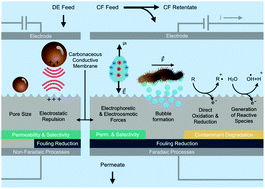Conductive carbonaceous membranes: recent progress and future opportunities†
Abstract
Electrically conductive membranes have shown tremendous promise in the treatment of water, due to their ability to overcome certain limitations that traditional membranes face. Membranes that can simultaneously serve as electrodes in an electrochemical cell can reduce membrane fouling, degrade contaminants, and even enhance permeability and selectivity in certain separations. Carbonaceous conductive materials are particularly promising for the creation of conductive membranes, due to their high surface area, high conductivity, excellent chemical and electrochemical stability, relative inertness, and wide chemical tunability, all of which are crucial in realizing the full benefits of electrically conductive membranes. In this perspective, we review recent work using carbonaceous conductive membranes for fouling mitigation, contaminant degradation, and permeability and selectivity enhancement, noting the advantages of carbonaceous conductive membranes in each and highlighting areas that we believe are promising future research directions. Based on current advancements, future work should be focused on disentangling mechanisms of fouling reduction, overcoming mass transfer limitations and testing more relevant model systems for contaminant degradation, and identifying large-scale application areas that can benefit from permselective functionality. We also perform a technoeconomic analysis for the addition of an electrified setup to an example desalination plant. Our analysis suggests that the future work towards commercialization should focus on improving the fouling reduction from electrification and reducing electrical energy consumption to justify the application of conductive carbonaceous membranes in water filtration and separation processes.



 Please wait while we load your content...
Please wait while we load your content...